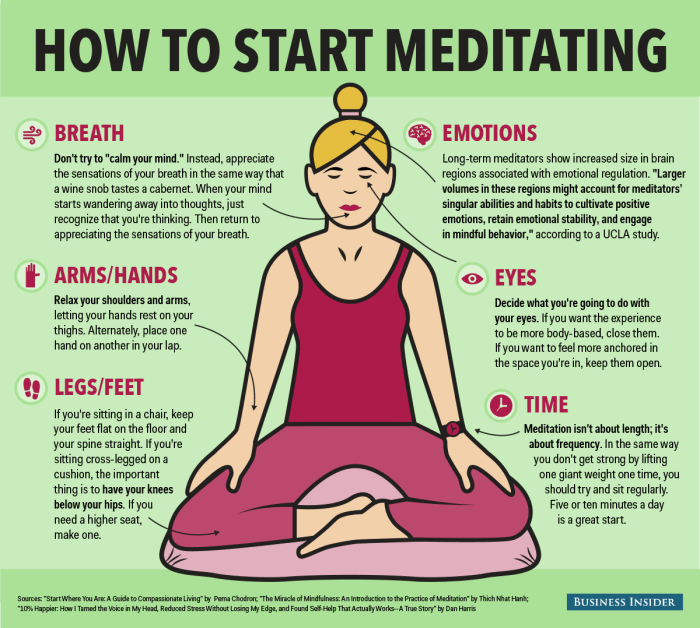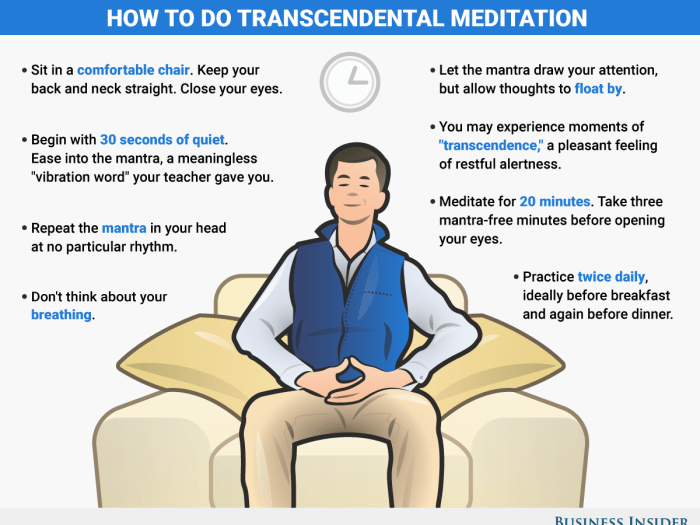Beginning with 10 Simple Meditation Techniques to Calm the Mind: A Guide to Inner Peace, embark on a journey towards tranquility and mental clarity through these effective practices.
Discover the power of meditation in fostering emotional well-being and reducing stress as we delve into various techniques designed to calm the mind and nurture inner peace.
Introduction to Meditation Techniques

Meditation is a powerful practice that has been used for centuries to calm the mind, reduce stress, and improve overall well-being. By incorporating meditation techniques into your daily routine, you can experience a myriad of benefits that positively impact your mental health.
Benefits of Meditation Techniques
- Reduces stress and anxiety levels
- Enhances focus and concentration
- Promotes emotional well-being
- Improves sleep quality
- Boosts self-awareness and mindfulness
Impact on Mental Health
Meditation has been scientifically proven to have a significant impact on mental health. Regular practice can help reduce symptoms of depression, anxiety, and other mental health disorders. It promotes a sense of calm and inner peace, allowing individuals to better cope with the challenges of daily life.
Breathing Exercises
Breathing exercises are an essential component of meditation practice, helping to calm the mind and bring focus to the present moment. By incorporating different breathing techniques, you can enhance your meditation experience and deepen your state of relaxation.
Different Breathing Techniques
- Deep Breathing: Inhale slowly and deeply through your nose, allowing your diaphragm to expand fully. Hold your breath for a few seconds, then exhale slowly through your mouth, releasing any tension or stress.
- Counted Breathing: Inhale to a count of four, hold for a count of four, and exhale to a count of four. This rhythmic breathing helps regulate your breath and calm the mind.
- Alternate Nostril Breathing: Close one nostril with your thumb and inhale through the other nostril. Switch nostrils and exhale through the opposite nostril. This technique balances the flow of energy in the body.
How Deep Breathing Helps Calm the Mind
Deep breathing triggers the body’s relaxation response, reducing stress and anxiety levels. It helps to slow down the heart rate, lower blood pressure, and increase oxygen flow to the brain, promoting a sense of calm and mental clarity.
Simple Breathing Exercise, 10 Simple Meditation Techniques to Calm the Mind
- Find a comfortable seated position with your back straight and shoulders relaxed.
- Close your eyes and take a deep inhale through your nose, counting to four.
- Hold your breath for a count of four, then exhale slowly through your mouth, also to a count of four.
- Repeat this cycle for several minutes, focusing on the sensation of your breath and letting go of any distractions or thoughts that arise.
Body Scan Meditation: 10 Simple Meditation Techniques To Calm The Mind

Body scan meditation is a mindfulness practice that involves focusing on each part of your body sequentially, from head to toe or vice versa. The purpose of body scan meditation is to increase body awareness, promote relaxation, and reduce stress and anxiety by bringing attention to physical sensations.
How Body Scan Meditation Can Reduce Stress and Anxiety
Body scan meditation can help reduce stress and anxiety by allowing you to tune into your body and notice areas of tension or discomfort. By bringing awareness to these sensations without judgment, you can release physical and emotional tension, promoting a sense of calm and relaxation.
- Start by finding a comfortable position either sitting or lying down.
- Close your eyes and take a few deep breaths to center yourself.
- Begin by focusing on your breath and gradually shift your attention to different parts of your body, starting from either your head or toes.
- As you scan each body part, notice any sensations you may be feeling, such as warmth, tingling, or tension.
- If you encounter areas of tension, breathe into them and imagine the tension melting away with each breath.
- Continue scanning each body part until you reach the opposite end, either your toes or head.
- Take a few moments to notice how your body feels as a whole and bring your awareness back to your breath before slowly opening your eyes.
Mindfulness Meditation

Mindfulness meditation is a practice that involves focusing on the present moment without judgment. It encourages individuals to pay attention to their thoughts, feelings, and sensations as they arise, fostering a sense of awareness and acceptance. This technique is particularly effective in calming the mind and reducing stress.
Examples of Mindfulness Meditation Techniques
- Body Scan: Start by focusing on each part of your body, from head to toe, noticing any tension or sensations. This helps in grounding yourself in the present moment.
- Breath Awareness: Concentrate on your breath, observing its rhythm and flow. When your mind wanders, gently bring your focus back to your breath. This practice enhances mindfulness and relaxation.
- Walking Meditation: Take slow, deliberate steps while paying attention to each movement and sensation. Walking mindfully can bring a sense of calmness and clarity to the mind.
Benefits of Incorporating Mindfulness into Daily Routines
- Stress Reduction: Mindfulness meditation can help lower cortisol levels and decrease anxiety, promoting overall relaxation and well-being.
- Improved Focus: By training the mind to stay present, mindfulness enhances concentration and cognitive function, leading to better focus and productivity.
- Emotional Regulation: Practicing mindfulness can increase emotional awareness and regulation, helping individuals respond to challenges with more clarity and composure.
Visualization Meditation
Visualization meditation is a technique that involves creating mental images to achieve a sense of relaxation, focus, and clarity. By visualizing peaceful scenes or positive outcomes, individuals can calm their minds and reduce stress levels. This practice can also help improve concentration, boost confidence, and enhance overall well-being.
Benefits of Visualization Meditation
- Reduces stress and anxiety levels
- Enhances focus and concentration
- Promotes a sense of calm and relaxation
- Boosts self-confidence and positivity
- Improves overall mental well-being
Visualization Techniques for Calming the Mind
- Beach Visualization: Imagine yourself on a peaceful beach, feeling the warmth of the sun, hearing the sound of the waves, and smelling the ocean breeze.
- Forest Visualization: Envision yourself walking through a serene forest, surrounded by tall trees, chirping birds, and the gentle rustling of leaves.
- Mountain Visualization: Picture yourself at the top of a majestic mountain, breathing in the fresh, crisp air and taking in the breathtaking panoramic views.
Tips to Enhance Visualization Meditation Practice
- Set aside dedicated time for visualization meditation each day to establish a routine.
- Create a quiet and comfortable space where you can fully concentrate on your visualization practice.
- Use all your senses to make the visualizations as vivid and realistic as possible.
- Practice deep breathing techniques while visualizing to deepen relaxation and focus.
- Avoid forcing the images and allow them to flow naturally, letting go of any distractions or judgments.
Walking Meditation
Walking meditation is a form of meditation where you practice mindfulness while walking. It is a moving meditation technique that involves focusing on the present moment and the sensations of walking. Unlike traditional sitting meditation, walking meditation allows you to cultivate mindfulness while in motion.The calming effects of walking meditation on the mind are profound. As you walk mindfully, paying attention to each step and your breath, you can experience a sense of grounding and relaxation.
Walking meditation can help reduce stress, anxiety, and promote mental clarity.
Step-by-Step Guide to Practicing Walking Meditation
- Find a quiet and safe place to walk, either indoors or outdoors.
- Start walking at a slow and steady pace, paying attention to the movement of your feet and legs.
- Focus on your breath as you walk, taking deep and mindful breaths with each step.
- Notice the sensations in your body as you walk, such as the feeling of the ground beneath your feet.
- Avoid distractions and stay present in the moment, letting go of any thoughts or worries that arise.
- Continue walking for at least 10-15 minutes, or longer if you feel comfortable.
- When you are ready to end your walking meditation, gradually slow down and come to a gentle stop.
- Take a moment to reflect on your experience and how you feel after practicing walking meditation.
Loving-Kindness Meditation
Loving-Kindness Meditation, also known as Metta Meditation, is a practice that involves cultivating feelings of love, kindness, and compassion towards oneself and others. The purpose of loving-kindness meditation is to develop a sense of connectedness with all beings, promote positive emotions, and reduce negative feelings such as anger, resentment, and stress.
Promoting Emotional Well-Being
- Loving-kindness meditation can promote emotional well-being by fostering feelings of empathy, compassion, and love towards oneself and others.
- Research has shown that regular practice of loving-kindness meditation can lead to increased feelings of happiness, gratitude, and overall emotional resilience.
- By focusing on sending positive thoughts and intentions to oneself and others, individuals can experience a sense of inner peace and emotional balance.
Cultivating Loving-Kindness Through Meditation
- Find a quiet and comfortable place to sit or lie down.
- Close your eyes and take a few deep breaths to relax your body and mind.
- Start by directing feelings of love and kindness towards yourself, repeating phrases like “May I be happy, may I be healthy, may I be safe, may I live with ease”.
- Next, extend these feelings towards loved ones, friends, acquaintances, and even towards people you may have difficulties with.
- Imagine sending waves of love and compassion to all beings, wishing them well and free from suffering.
- Practice loving-kindness meditation regularly to strengthen your ability to cultivate feelings of love, kindness, and compassion towards yourself and others.
Chanting or Mantra Meditation
Chanting or mantra meditation is a powerful practice that can help calm the mind and deepen your meditation experience. By repeating a specific sound, word, or phrase, you can focus your mind and create a sense of peace and tranquility.
Significance of Repetitive Sounds in Meditation
- Repetitive sounds in meditation serve as a point of focus, allowing you to quiet the mental chatter and distractions that often cloud the mind.
- By chanting a mantra or specific sound, you can enter a state of deep concentration and relaxation, helping to reduce stress and anxiety.
- The rhythmic repetition of sounds can also have a soothing effect on the nervous system, promoting overall well-being and inner peace.
Popular Mantras or Chants for Meditation
- Om: The sacred sound of “Om” is one of the most widely used mantras in meditation practices. It is believed to represent the sound of the universe and can help align your energy with the cosmic vibrations.
- So Hum: This mantra translates to “I am that” in Sanskrit and can be used to connect with the universal consciousness and your true self.
- Om Mani Padme Hum: A Tibetan Buddhist mantra, this chant is associated with compassion and is believed to purify the mind and body.
Progressive Muscle Relaxation

Progressive Muscle Relaxation is a relaxation technique that involves tensing and then relaxing specific muscle groups in the body. This method helps release physical tension and promotes a sense of calmness in the mind.
Step-by-Step Guide
- Find a quiet and comfortable place to sit or lie down.
- Start by focusing on your breathing, taking slow and deep breaths.
- Begin by tensing a specific muscle group, such as your hands or shoulders, and hold the tension for a few seconds.
- Then, release the tension in that muscle group, allowing it to relax completely.
- Move on to the next muscle group, repeating the process of tensing and relaxing.
- Continue this sequence throughout your body, from head to toe.
- Take your time with each muscle group and pay attention to the sensations of tension and relaxation.
- Finish the session by taking a few deep breaths and slowly bringing your awareness back to the present moment.
Benefits of Progressive Muscle Relaxation
- Reduces physical tension and promotes relaxation.
- Helps alleviate stress and anxiety.
- Improves sleep quality by calming the body and mind.
- Enhances body awareness and mindfulness.
- Can be easily incorporated into meditation routines for added benefits.
Guided Meditation

Guided meditation is a form of meditation where an individual is led through a series of visualizations or instructions by a trained practitioner, teacher, or recorded audio. This practice is especially beneficial for beginners who may find it challenging to meditate on their own. Guided meditation can help calm the mind by providing a focus point and guiding the individual through the meditation process.
It can assist in reducing stress, anxiety, and promoting relaxation by offering a structured approach to meditation. The guided instructions help in keeping the mind from wandering and encourage a sense of presence and mindfulness.
Benefits of Guided Meditation for Beginners
- Provides structure and guidance for those new to meditation.
- Helps in developing a meditation routine by following pre-recorded sessions.
- Offers a sense of community and support through guided meditation classes or online platforms.
- Aids in relaxation and stress reduction by providing a calming and soothing experience.
Finding Guided Meditation Sessions
- Apps like Headspace, Calm, and Insight Timer offer a variety of guided meditation sessions for all levels.
- Online platforms such as YouTube and meditation websites provide free guided meditation videos and audio recordings.
- Local meditation centers or yoga studios may offer guided meditation classes with experienced instructors.
- Books and CDs with guided meditation practices can also be found in libraries or online stores for personal use.
Summary
In conclusion, incorporating these 10 simple meditation techniques into your daily routine can lead to a more peaceful and balanced state of mind. Start your meditation journey today and experience the transformative benefits firsthand.